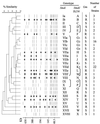Phenotypic and molecular typing of nosocomial methicillin-resistant Staphylococcus aureus strains susceptible to gentamicin isolated in france from 1995 to 1997
- PMID: 10618085
- PMCID: PMC88693
- DOI: 10.1128/JCM.38.1.185-190.2000
Phenotypic and molecular typing of nosocomial methicillin-resistant Staphylococcus aureus strains susceptible to gentamicin isolated in france from 1995 to 1997
Abstract
Methicillin-resistant strains susceptible to gentamicin (Gm(s) MRSA) have emerged since 1993 in several French hospitals. To study whether particular clones have spread in various French cities and whether some clones are related to gentamicin-resistant (Gm(r)) MRSA strains, various methods (antibiotyping, phage typing, determination of SmaI macrorestriction patterns before and after hybridization with IS256 transposase and aacA-aphD probes) were used to compare 62 Gm(s) MRSA strains isolated from 1995 to 1997 in nine cities and 15 Gm(r) MRSA strains. Eighteen major SmaI genotypes were identified, of which 11 included only Gm(s) MRSA strains and 5 included only Gm(r) MRSA strains. Each of the Gm(r) MRSA strains contained 6 to 13 SmaI fragments hybridizing with the insertion sequence IS256, of which a single band also hybridized with the aacA-aphD gene. No such hybridizing sequences were detected in 60 of the 62 Gm(s) MRSA strains. Thus, the divergence between Gm(r) and Gm(s) MRSA strains is revealed, not only by their distributions in distinct SmaI genotypes but also by the differences in hybridization patterns. Two of the 62 Gm(s) MRSA strains had the uncommon feature of carrying several SmaI bands hybridizing with IS256, suggesting that they are possibly related to the Gm(r) MRSA strains grouped in the same SmaI genotype. Five of the 11 SmaI genotypes including only Gm(s) MRSA strains contained strains from diverse cities, isolated during different years and with different antibiograms, suggesting that some clones have spread beyond their cities of origin and persisted.
Figures


References
-
- Aubry-Damon H, Legrand P, Brun-Buisson C, Astier A, Soussy C-J, Leclercq R. Reemergence of gentamicin-susceptible strains of methicillin-resistant Staphylococcus aureus: roles of an infection control program and changes in aminoglycoside use. Clin Infect Dis. 1997;25:647–653. - PubMed
-
- Berger-Bächi B. Resistance not mediated by β-lactamase (methicillin-resistance) In: Crossley K B, Archer G L, editors. The Staphylococci in human disease. New York, N.Y: Churchill Livingstone; 1997. pp. 158–174.
-
- Byrne M E, Rouch D A, Skurray R A. Nucleotide sequence analysis of IS256 from the Staphylococcus aureus gentamicin-tobramycin-kanamycin-resistance transposon Tn4001. Gene. 1989;81:361–367. - PubMed
-
- Chabbert Y A. Sensibilité bactérienne aux antibiotiques. In: Le Minor L, Veron M, editors. Bactériologie Médicale. Paris, France: Flammarion, Médecine Science; 1982. pp. 204–212.
MeSH terms
Substances
LinkOut - more resources
Full Text Sources
Medical
Research Materials

